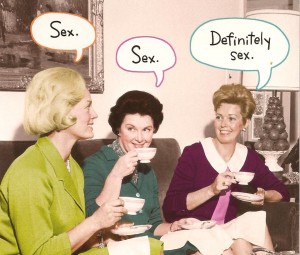A friend sent me this Hallmark ShoeBoxcard. (Visit a Hallmark store today.)
Women’s missing libido is legendary. Consider the accepted “fact:: men think about sex every seven seconds; women think about sex seven times a year. There’s the classic bit from Woody Allen’s Annie Hall. Annie and Woody’s character, Alvy, each tell the therapist that they have sex 2-3 times per week. Alvy labels this “hardly ever, never.” Annie says that it’s “all the time.” Books lament today’s sexless marriages.
The problem lies in expectations –and unquestioning acceptance– that a woman’s libido goes missing in action for years. Sex drive drops as work demands pile up. Children come along, constantly tugging, clinging, and creating mommy “touch fatigue.” Sometimes, women believe “mothers don’t do those things.” Fluctuating hormones take a toll, with breastfeeding, perimenopause, and menopause. Not to mention when women are constantly running on empty and even simple self-renewal like sleep, exercise, or fun stays on the bottom of the list for weeks on end.
Women can reclaim this most basic need by tuning into the benefits. Feelings of closeness to your partner rise with levels of the hormone oxytocin, which jumps to five times normal levels. Oxytocin increases drowsiness, easing sleep. Research has shown that orgasm releases endorphins, like a runner’s high, relieving pain of cramps and headaches. Endorphins boost mood and ease PMS irritability, too. Finally, the neurotransmitter dopamine rises, enhancing lust and the relaxation response. This explains why libido is enhanced by an active sex life. “Use it or lose it” is not a myth.
Acknowledging the benefits encourages us to put satisfying sex back on the list ,for ourselves, not just to assuage our fears of a wandering partner. But how to rebuild the missing link?
Cynthia Kling in A Bitch in the House nails it: “eventually the pure animal rutting feeling stops rising out of your depths, and that’s when you need … your brain to take over and bring it back.” Plan to ignite that sleepy part of your brain by simply allowing yourself to think about sex.
Read a sexy novel. Watch artfully crafted sex scenes in a movie –no porn required. Sex scenes are often labeled “gratuitous sex,” designed to lure young movie-goers. Who says we can’t enjoy them –if we allow ourselves to embrace this basic human response.
Then make time for sex, by handing over household/childcare chores, a carrot on a stick, to that hopefully willing partner. Young moms, in particular, can delegate bedtime rituals to dad for at least one night. Take the free time to relax in the tub, daydream, delve into erotica. Brent Bost, MD, author of The Hurried Woman, affirms it: the best aphrodisiac in the world is a man with a vacuum cleaner.
